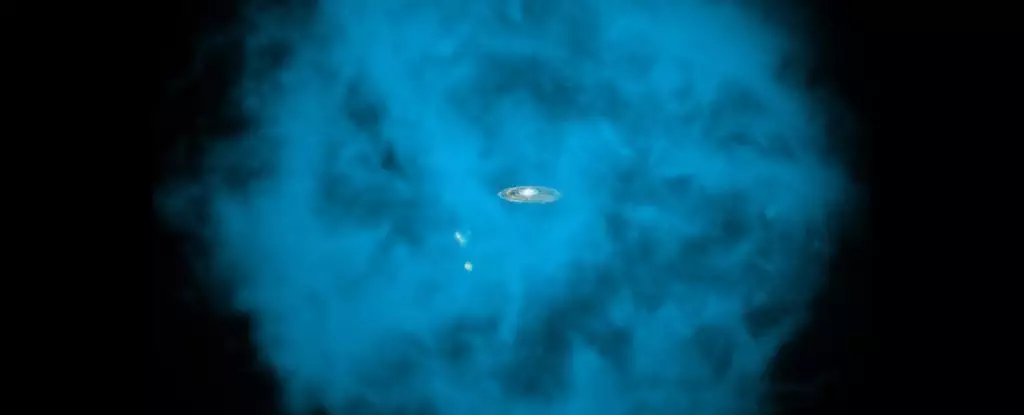For many decades, the scientific community has grappled with an enigmatic question: where is the missing half of the Universe’s visible matter? After all the advances in astronomy and various observational techniques, the truth remained shrouded in secrecy. Thanks to cutting-edge research led by an extensive international team of astronomers and astrophysicists, we are beginning to unveil the mystery. The findings confirm that this elusive matter primarily exists as vast clouds of ionized hydrogen, floating quietly in the space surrounding galaxies. What’s most astonishing is that these clouds have gone unnoticed, hidden in the cosmic abyss for so long.
Previously deemed inconceivable, scientists now employ a novel methodology that allows them to identify these hidden reservoirs of matter. This breakthrough is not just another box checked on a long list of cosmic questions; it’s a paradigm shift in our understanding of the Universe. We’ve long been aware of baryonic matter, which constitutes about 5% of the total matter-energy content in the Universe, but now we can finally link the other half of its missing baryons to the intergalactic mist of hydrogen, residing farther from galactic cores than ever assumed.
The Nature of Baryonic Matter
Baryonic matter is essential to the structure and evolution of the Universe, yet its considerable absence has puzzled researchers for epochs. It’s primarily made up of hydrogen—an element crucial not only for star formation but also for our overall comprehension of cosmic development. While dark energy and dark matter comprise 95% of the Universe’s total mass-energy content, their nature remains an enigma, oftentimes overshadowing the more concrete presence of baryonic matter. Thus, identifying and quantifying baryons is vital for our scientific pursuits.
In the mix, hydrogen—accounting for about 90% of the Universe’s atomic structure and roughly 73% of its mass—emerges as a central player in the tale of the missing baryons. Researchers estimate that over half of the pre-existing hydrogen in the Universe is MIA, fueling intense scholarly interest and exploration. While ionized hydrogen can glow faintly when influenced by radiation, the specter of this gas remains elusive in the vast expanses between galaxies. Traditional observational techniques often fail to detect this diffusion, rendering our understanding of cosmic evolution incomplete.
Illuminating the Shadows
The recent breakthroughs hinge upon the innovative application of the kinematic Sunyaev-Zel’dovich effect, enabling astronomers to exploit the cosmic microwave background as a cosmic “backlight.” As this primordial radiation travels through clouds of ionized hydrogen, it experiences variations in brightness, revealing the position and distribution of the invisible gas. The researchers skillfully stacked data from a million glowing red galaxies within an 8 billion light-year radius of the Milky Way to amplify the faint signals that mark these hidden halos.
What they discovered was shocking: the halos of hydrogen surrounding these galaxies appear to be much larger than previously imagined. This newfound understanding promises much more than just answering a lingering question; it opens new avenues for inquiry and exploration. As scientists parse this data, they must also confront the implications of unexpectedly large gaseous halos surrounding galaxies. Could these halos signify episodic behavior in supermassive black holes, which can spur immense jets of material into intergalactic space? These revelations will undoubtedly reshape our comprehension of galaxy formation and evolution.
The Intricacies of Cosmic Relationships
Interestingly, the scale of these hydrogen halos also brings to light further questions regarding how baryonic matter interacts with dark matter—a connection that is as vital to understanding galaxy formation as it is to the broader understanding of the Universe’s structure. Previous studies have indicated that some missing baryons might be intertwined within dark matter filaments forming the cosmic web.
As researchers synthesize their findings, they reach a critical juncture in astrophysics. The presence of hydrogen not only suggests an uncharted territory in our cosmic map but also alters our understanding of galaxy dynamics, star formation, and the complex role dark matter plays in shaping the Universe.
The implications of this research are multifaceted and transformative, presenting a radical new framework wherein the interrelationship between gas and dark matter could redefine our analytical tools for future cosmological studies. As we embrace these revelations, the fate of the Universe and its myriad secrets seem closer than ever to unveiling themselves, marking a new chapter in humanity’s quest for knowledge about our cosmic home.

